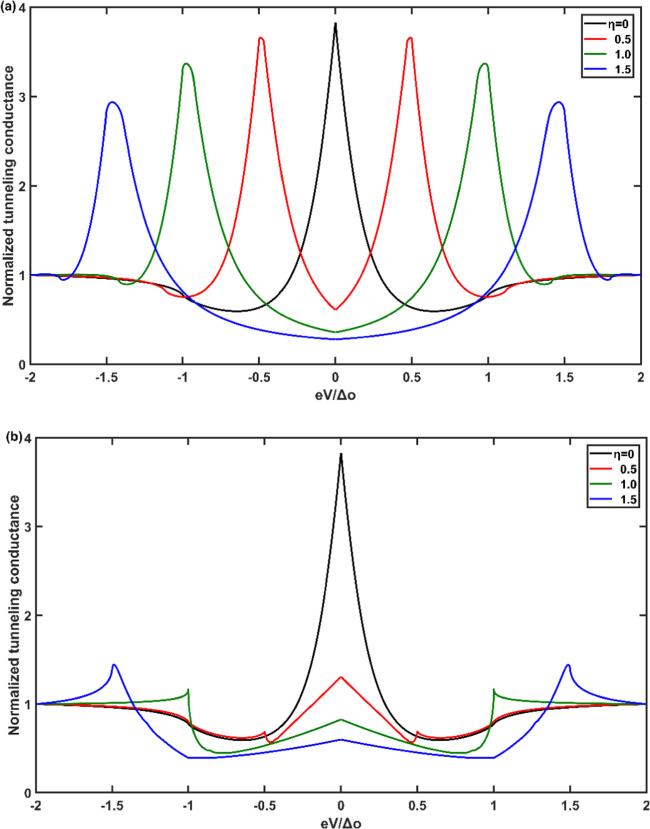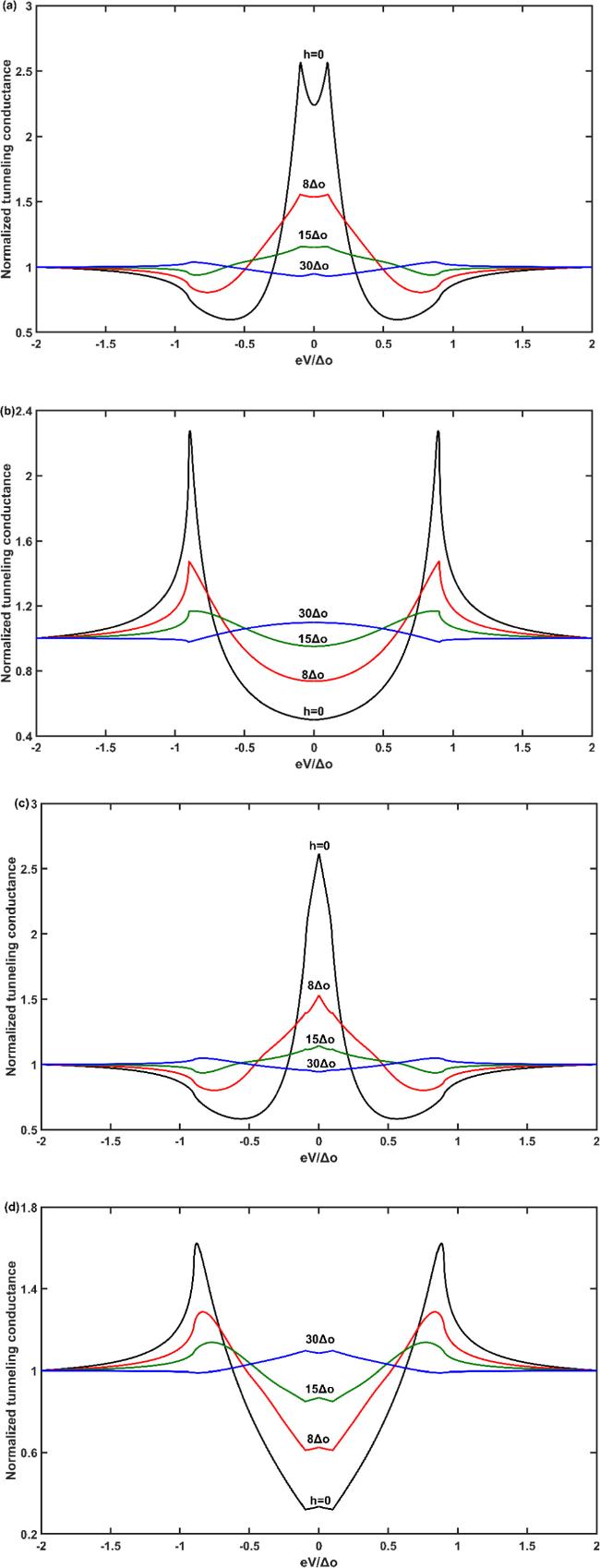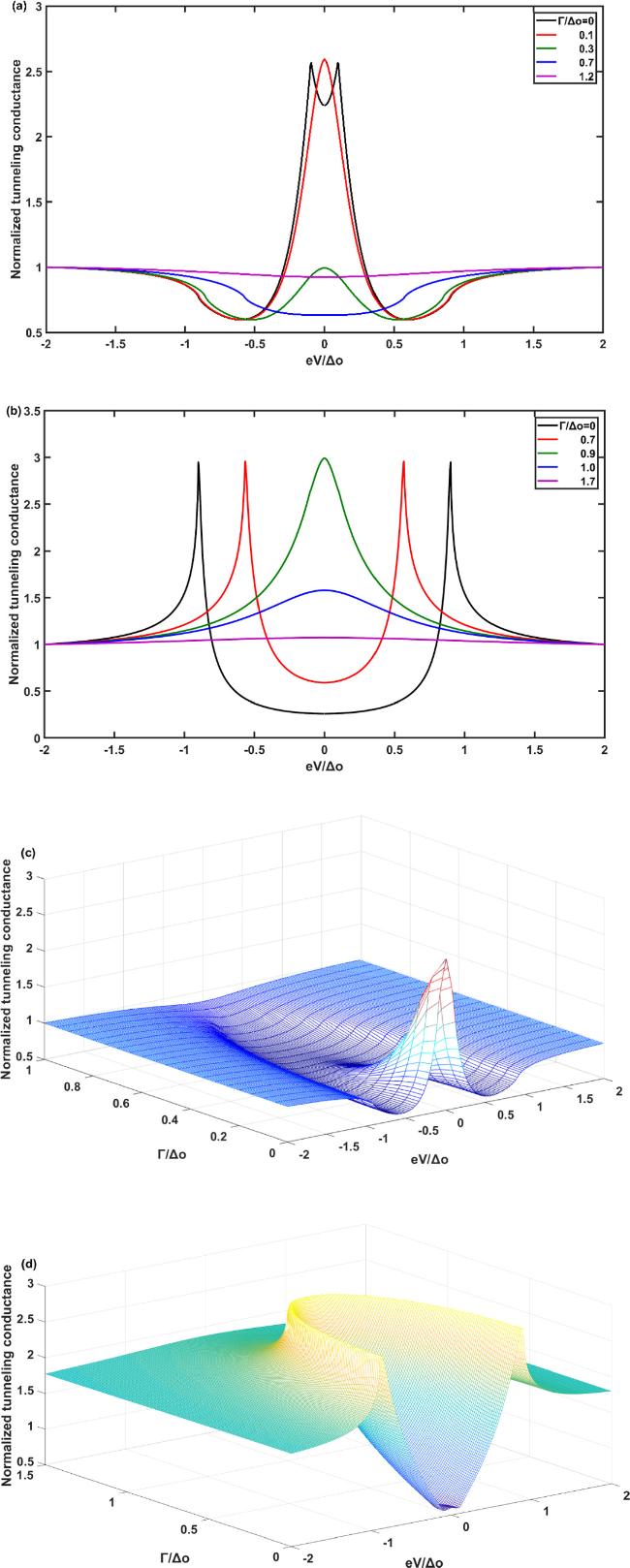We first discuss the effect of the TRSB on the normalized tunnel conductance. The results are given in figure
1, where (a) and (b) are two plotted cases of
${d}_{{x}^{2}-{y}^{2}}+is$ -wave and
${d}_{{x}^{2}-{y}^{2}}+i{d}_{xy}$ -wave, respectively. As can be seen from the two figures, when
$\eta =\displaystyle \frac{{{\rm{\Delta }}}_{s}}{{{\rm{\Delta }}}_{D}}\left(\displaystyle \frac{{{\rm{\Delta }}}_{d}}{{{\rm{\Delta }}}_{D}}\right)=0,$ as a typical characteristic of
${d}_{{x}^{2}-{y}^{2}}$ -wave and [110] orientation, the ZBCP is obtained. This ZBCP indicates the existence of a zero-energy Andreev bound state (ABS) of superconducting tunnel junction. The formation of ABS is explained physically as follows. From equation (
1), it can be seen that when
$\eta =\displaystyle \frac{{{\rm{\Delta }}}_{s}}{{{\rm{\Delta }}}_{D}}\left(\displaystyle \frac{{{\rm{\Delta }}}_{d}}{{{\rm{\Delta }}}_{D}}\right)=0$ and
$\alpha =0.25\pi ,$ the pair potential for injected quasiparticles and reflected quasiparticles can been written as
${\rm{\Delta }}={{\rm{\Delta }}}_{D}\,\sin \left(2{\theta }_{S}\right)$ and
${\rm{\Delta }}={{\rm{\Delta }}}_{D}\,\sin \left[2\left(\pi -{\theta }_{S}\right)\right]\,=-{{\rm{\Delta }}}_{D}\,\sin \left(2{\theta }_{S}\right),$ respectively. The signs of the pairing potential for the incident particles and its reflected particles are obviously opposite. This results in an interference effect between them, thus forming the zero-energy ABS. This zero-energy ABS leads to the ZBCP [
24]. For NM/I/FM/
${d}_{{x}^{2}-{y}^{2}}+is$ -wave superconducting structures, as shown in figure
1(a), when
$\eta =\displaystyle \frac{{{\rm{\Delta }}}_{s}}{{{\rm{\Delta }}}_{D}}\ne 0,$ the ZBCP splits into two high-energy conductance peaks. With the increase in
$\eta ,$ that is, with the enhancement of the
s-wave subcomponent, the amplitude of the splitting peaks decreases and the distance between the peaks increases. It is worth noting that the position of the two peaks appear at exactly
$\displaystyle \frac{eV}{{{\rm{\Delta }}}_{0}}=\pm \displaystyle \frac{{{\rm{\Delta }}}_{s}}{{{\rm{\Delta }}}_{D}}.$ Our result includes the experimental phenomenon in [
25]. For NM/I/FM/
${d}_{{x}^{2}-{y}^{2}}+i{d}_{xy}$ -wave superconducting structures, as shown in figure
1(b), when
$\eta =\displaystyle \frac{{{\rm{\Delta }}}_{d}}{{{\rm{\Delta }}}_{D}}\ne 0,$ the ZBCP still exists. At the same time, there are also high-energy conductance peaks at
$\displaystyle \frac{eV}{{{\rm{\Delta }}}_{0}}=\pm \displaystyle \frac{{{\rm{\Delta }}}_{d}}{{{\rm{\Delta }}}_{D}},$ but the values of the peaks are smaller than those of the NM/I/FM/
${d}_{{x}^{2}-{y}^{2}}+is$ -wave SC junction tunnel spectrum. Unlike the NM/I/FM/
${d}_{{x}^{2}-{y}^{2}}+is$ -wave SC tunnel junction, with the increase in
$\eta ,$ that is, with the enhancement of the
${d}_{xy}$ -wave component, the value of the ZBCP becomes smaller and smaller, while the value of the two non-zero-bias conductance peaks becomes larger and larger. We explain all the different behaviors of the tunnel spectrum caused by
s- and
${d}_{xy}$ -wave subcomponents as follows. The induced
s-wave component breaks the symmetry of time inversion, blocks the transport of the quasiparticles and causes the zero-energy ABS to no longer be stable. Thus, the energy level of ABS shifts from zero to
$eV=\pm \displaystyle \frac{{{\rm{\Delta }}}_{s}}{{{\rm{\Delta }}}_{D}}{{\rm{\Delta }}}_{0}$ and the ZBCP splits accordingly into two conductance peaks. For the induced
${d}_{xy}$ -wave component, equation (
1) shows that when
$\eta =\displaystyle \frac{{{\rm{\Delta }}}_{s}}{{{\rm{\Delta }}}_{D}}\left(\displaystyle \frac{{{\rm{\Delta }}}_{d}}{{{\rm{\Delta }}}_{D}}\right)=0$ and
$\alpha =0.25\pi ,$ the same as for the
${d}_{{x}^{2}-{y}^{2}}$ -wave, signs of the pairing potential for the incident particles and its reflected particles are opposite. Therefore, although it also breaks the symmetry of the time inversion, the zero-energy ABS still exists, and correspondingly, the ZBCP also exists. It should be mentioned that although we take
L = 5 nm here, it is calculated that the length
L of ferromagnetic metal does not affect the splitting behavior caused by the
s-wave subcomponent. The above results of the tunnel spectrum of NM/I/FM/
${d}_{{x}^{2}-{y}^{2}}+is$ -wave and NM/I/FM/
${d}_{{x}^{2}-{y}^{2}}+i{d}_{xy}$ -wave SC tunnel structures can be used to experimentally distinguish
${d}_{{x}^{2}-{y}^{2}}$ -wave from the mixed wave
${d}_{{x}^{2}-{y}^{2}}+is$ or
${d}_{{x}^{2}-{y}^{2}}+i{d}_{xy},$ and also to determine whether the TRSB is caused by subdominant pair potential
s-wave or
${d}_{xy}$ -wave.






